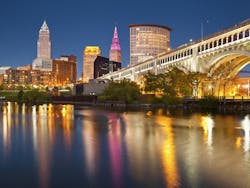Two Cleveland, Ohio institutions laid out plans this week for an ambitious $100 million microgrid to create an uninterruptible power supply for businesses, public institutions and facilities in the city’s downtown.
Downtown Cleveland by Rudy Balasko/Shutterstock
With a size and scope seen in few microgrids to date, the project would encompass Cleveland’s central business district, a two- to three-square-mile area, bound roughly by Interstate 90 and the Cuyahoga River.
Cleveland State University’s Energy Policy Center and the Case Western Reserve University’s Great Lakes Energy Institute presented microgrid techno-economic and economic-fiscal impact studies for the project this week during the NASA Glenn Research Center’s EnergyTech 2018.
Project proponents see an opportunity to boost downtown Cleveland’s economy and reduce greenhouse gas emissions and other pollutants. With a combined heat and power system (CHP) at its core, the microgrid would leverage low-cost natural gas — including that being extracted from Ohio’s Marcellus and Utica shales — along with renewables and energy storage.
Owned and operated by downtown district thermal energy provider Cleveland Thermal, the proposed CHP plant would produce a maximum of 48 MW, delivered to customers through three tiers of electricity services via Cleveland Public Power’s distribution grid, according to Andrew Thomas, executive in residence at CSU’s Energy Policy Center, one of the project’s originators and driving forces.
Project planners expect the microgrid’s electricity to cost customers about 14 cents/kWh, which is more than the average cost of grid power. But the microgrid would deliver premium power at 99.999 percent availability with less than six minutes of outages per year, according to the project feasibility study team.
The seeds of Cleveland’s $100 million microgrid
The idea for the microgrid grew out of discussions between Cleveland Foundation CEO Ronn Richard and Cuyahoga County Executive Armond Budish regarding today’s transition from centralized to decentralized power. Thomas got involved in those discussions about a year and a half ago.
“Initially, we were working on a strategy based on use of offshore wind power from Lake Erie, along with solar power generation and energy storage,” Thomas said in an interview. “We didn’t see the collapse in the price of natural gas persisting, but the entire conceptualization of a microgrid project accelerated based on using CHP as a source of power. It’s highly efficient and runs on cheap natural gas, and it’s possible to bring in other resources but rely on CHP as the primary source of energy.”
Cleveland Thermal seemed to be a natural choice as the CHP plant’s owner and operator. The district energy provider’s steam and chilled water distribution network lies beneath the streets of downtown Cleveland, and the company had been looking to add electricity generation and distribution to its heating and cooling services, Thomas said.
“They were a significant part of this from the very beginning, as was the city through our municipal utility (Cleveland Public Power) and Cuyahoga County,” he said.
Three tiers of microgrid service
The downtown Cleveland microgrid project study team devised the project’s three electricity service tiers based primarily on the “Value of Lost Load” (VOLL), as well as other expenses incurred by businesses located across the study area.
Using Economic Development NAICS (North American Industry Classification System) codes and factors specific to each industry and geographic sector, the team categorized businesses in each tier based on their willingness to pay for:
- Tier 1: Reliable, uninterruptible electricity for a premium
- Tier 2: Mid-level reliability tier at a lesser premium; electricity services are still a step above typical, utility service
- Tier 3: Electricity service of higher quality than typical utility service, available in the event of utility grid outages
The researchers sized the microgrid at 48 MW to serve the needs of commercial and institutional customers downtown — about 13 MW for Tier 1 service customers, another 8 MW for Tier 2 and the remainder for Tier 3. Total project cost was estimated at $100 million over a projected 30-year system life.
Regardless of which tier customers choose, “everyone would see an improved quality of power during normal operating times and conditions, as well as be assured they would continue to have power in the event of utility grid outages,” Thomas said. “Microgrid control systems prevent the voltage and frequency sags typically experienced on utility grids. These can be very damaging and costly, particularly for data centers, hospitals and other organizations that have a critical need for continuous, high-quality power.”
Cleveland businesses willing to pay for premium service
By Krisana Antharith/Shutterstock.com
The project team determined that a microgrid operator would need to sell power to customers at about 13-14 cents/kWh to be profitable. Commercial customers in Ohio pay an average 9 cents/kWh for utility grid service, according to the project feasibility research team.
Utility rates for commercial customers in downtown Cleveland probably run a little higher — around 10-12 cents/kWh. Thomas pointed out that CSU currently pays even less, about 7 cents/kWh, a price it achieves by buying power on the competitive market.
“CSU has a load of about 10 MW, which is supplied by a commercial retail electricity service company delivered through FirstEnergy’s distribution subsidiary, Cleveland Electric Illuminating Company. The retail power market is very competitive in Ohio right now and we’re able to get a very good deal,” Thomas said.
He added: “Distributed energy technologies such as microgrids, solar, wind and combined heat and power have to compete with power provided from retail providers operating in PJM’s territory. This is not easy. Electricity is inexpensive in Ohio at present. We have some of the cheapest natural gas prices in the world here.”
Hence, one of the main issues the research team needed to resolve was if businesses were willing to pay as much as 5 cents/kWh more for electricity service with “five- or six-nines” (99.999 or 99.9999%) availability, Thomas explained.
Twenty-five percent of some 155 companies said they would be willing to pay the 5 cents/kWh premium
In a previous study, the Cleveland microgrid project feasibility research team determined the value of energy resilience to commercial customers with a critical need for high-quality, continuous power — a hospital, medical or scientific research center or data center, for instance.
To do so, the team compared the cost for organizations to build versus buy energy services with five- or six-nines availability. The costs were then spread over the typical, expected life of the type of the technology used — about seven years for a typical UPS system, around 15 years for diesel-generation emergency back-up, etc.
At the end of the day, the all-in costs fell in a range between 5-20 cents/kWh.
“We confirmed this with company interviews. We estimated the extra, marginal cost at 5 cents per kWh, then did a national survey and found that 14 cents/kWh was a good threshold number,” Thomas said.
Twenty-five percent of some 155 companies said they would be willing to pay the 5 cents/kWh premium. Twenty percent said they would consider relocating or building new facilities within the downtown microgrid service area, according to the survey results.
Microgrid earnings of $162 million
Some of which would flow to the city and county via taxes…
The project team then carried out an economic and fiscal impact analysis that zeroed in on project financing, a business model and companies that had the highest cost for power outages, or VOLLs. Six industry sectors were selected. The list was then narrowed down to the top three. The researchers proceeded to look at the growth rates of these top three categories of companies in downtown Cleveland, which turned out to be less than 1 percent per year during the previous six years, according to Thomas.
Aiming to determine what the economic impacts of building the microgrid might be, the study team subtracted the downtown Cleveland business growth rate from the national average growth rate for those industry categories — a growth rate of 2-3 percent per year, Thomas explained. Among other findings, the study team determined building the downtown Cleveland microgrid could create some 2,264 new job and generate annual earnings of nearly $162 million, some of which would flow to the city and county via taxes.
RFI/RFP from city and county
Following Ohio State’s lead
The plan calls for use of the same project management tools and mechanisms Ohio State University used when it outsourced and privatized energy services and management to Engie, Thomas explained. The proposal recommends the city and county issue a request for expressions of interest (RFI) followed by a request for proposals (RFP) to choose a microgrid builder/owner/operator.
“I think that the plans to build the CHP plant is really what makes this feasible. Then there are all the other aspects of the project, including ensuring that the microgrid is immune to cyberthreats and cyberattacks,” Thomas said.
However, the driving force for the project comes down to the recognition by city leaders and the Cleveland Foundation that a transformation of power technology, industry and markets is under way, and that those who do not participate will be left behind, he added.
Why Cleveland needs more reliable power
It’s not just about storms…
Cleveland experiences a low number of extreme weather events — still companies need more reliable power.
“[The state’s] utility grids are relatively stable, with 99.93 percent up-time, but that’s not high enough for the industries of tomorrow emerging today,” Thomas said. “Companies using or looking to use Internet of Things’ technology need five- or six-nines [power] availability.”
Independent, new tech-driven power industry companies say they can do that. Having outsourced energy services and management to Engie, Ohio State is pursuing such reliability for its entire campus — some 50,000 students, according to Thomas. “Engie warranted five-nines availability, and it’s working with Schneider Electric to realize that,” Thomas said.
Cleveland Public Power does have power distribution lines that might be able to serve the downtown-center microgrid, but the project team proposes building new, dedicated power distribution lines to ensure the reliability, resilience and oveall quality of electricity service delivered via the microgrid.
“We specify new, dedicated, underground power lines to be owned by Cleveland Public Power for an estimated 50 customers from the microgrid substation to the downtown-area clients in the study,” Thomas said.
The fiber optic network would be built, owned and operated by the microgrid owner-operator, he added.
Looking ahead, the next step for the proposal is a thorough review by city and county leaders and officials. Cuyahoga provided funding to carry out the feasibility study and they have expressed strong interest in learning more about the project and its costs and benefits. Similarly, the city, through the city’s municipal utility, has been involved in the research.
“The really important thing here is that the city and county have to educate themselves regarding the results of the studies,” Thomas said. “If they decide to go ahead, our recommendation is for them to follow Ohio State’s course and put out an RFI, narrow responses down three or so companies with sensible proposals, then issue an RFP to narrow that down to a final selection. The critical points that need to be very clear here is who is going to off-take the power and what are they going to pay?”
Track news about the Cleveland microgrid. Subscribe to the free Microgrid Knowledge newsletter.







